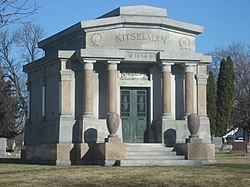
This is a list of the National Register of Historic Places listings in Henry County, Indiana.

Muncie's Masonic Temple is a historic fraternal lodge building located in Muncie, Indiana. The building is now only used by the Cornerstone Center for the Arts. The Muncie Masonic Temple is in the Gothic Revival style, and was designed and built during the height of the City Beautiful Movement.

The Carnegie Library is a historic Carnegie library located at Muncie, Indiana, United States. The building houses the Local History & Genealogy collection and an open computer lab. The facility also provides wireless access and a meeting room for local groups to reserve. It is one of four branches that make up the Muncie Public Library System. The building was made possible through a financial donation to the City of Muncie by Andrew Carnegie to expand their library system throughout the community. The foundation for Carnegie Library was built in 1902 and the building opened to the public in 1904. It has been in continuous use as a library since its opening. The building is located in downtown Muncie at the intersection of Jackson and Jefferson.

Wing & Mahurin was an architectural firm of Fort Wayne, Indiana. Its principal partners were John F. Wing (1852-1947) and Marshall S. Mahurin (1857-1939), who were partners until 1907. Together with Guy M. Mahurin (1877-1941) they worked also as Mahurin & Mahurin.
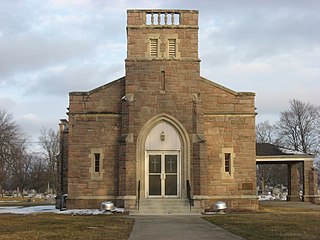
Oak Hill Cemetery is a historic cemetery located at Lebanon, Boone County, Indiana. The cemetery was established in 1872 as Rodefer Cemetery, and includes many noteworthy examples of Victorian funerary art. Other notable features are the Late Gothic style William L. Powell Chapel (1930), office building (1955), English barn, the Romanesque Revival style main gate, north gate, the original mausoleum, Metzger Mausoleum, Heath Mausoleum, and Stokes Mausoleum. Notable burials include Indiana governor and U.S. Senator Samuel M. Ralston (1857–1925).
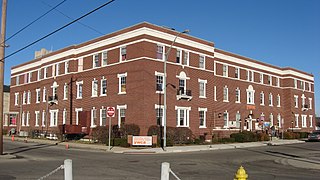
YWCA is a historic YWCA building located at Muncie, Delaware County, Indiana. It was built in 1925, and is a three-story, five bay by three bay, restrained Colonial Revival style brick building with limestone detailing. It has swimming pool in the basement, meeting and recreation rooms on the first floor, and sleeping rooms on the second and third floors.

City Hall was a historic city hall building located at Muncie, Delaware County, Indiana. It was built in 1925, and was a three-story, L-shaped, Renaissance Revival style brick building with terra cotta detailing. It has been demolished.

Goldsmith C. Gilbert Historic District is a national historic district located at Muncie, Delaware County, Indiana. It encompasses 75 contributing buildings and is located in the oldest residential section of Muncie. The district includes notable examples of Late Victorian, Colonial Revival, and Bungalow / American Craftsman style architecture. Located in the district is the separately listed J.C. Johnson House. Other notable buildings include the A.L. Johnson House, Meeks Mortuary Building, Joseph Hummel House, and Miller Livery (1916).
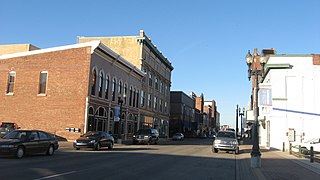
Walnut Street Historic District is a national historic district located at Muncie, Delaware County, Indiana. It encompasses 66 contributing buildings and 1 contributing object, and is located in the central business district of Muncie. The district includes notable examples of Italianate, Late Victorian, Colonial Revival, and Beaux-Arts style architecture. Located in the district are the separately listed Moore-Youse-Maxon House, Roberts Hotel, and Goddard Warehouse. Other notable buildings include the Patterson Bock, McNaughton Block (1901-1903), Mitchell Block (1909), American National Bank Building (1924), Marsh Block (1888), and the Old Post Office designed by the Office of the Supervising Architect under James Knox Taylor.

Wysor Heights Historic District is a national historic district located at Muncie, Delaware County, Indiana. It encompasses 61 contributing buildings, 1 contributing site, and 1 contributing object in a predominantly residential section of Muncie. The district developed between about 1890 and 1930, and includes notable examples of Queen Anne, American Foursquare, and Bungalow / American Craftsman style architecture. Notable contributing resources include the equestrian sculpture and landscape ensemble "Appeal to the Great Spirit" by Cyrus Edwin Dallin (1929), Roy Thomas House (1922-1923), Burt Whiteley House (1892), and the first Delaware County Children's Home building.

Old West End Historic District is a national historic district located at Muncie, Delaware County, Indiana. It encompasses 273 contributing buildings in a predominantly residential section of Muncie. The district largely developed between about 1880 and 1915, and includes notable examples of Late Victorian style architecture. Notable buildings include Temple Beth-El (1922), First Church of Christ Scientist, Wittmore Apartments, Martin Sisters House (1879-1880), Christian Church / Wesleyan Chapel (1875), Vandercook House (1887), First English Lutheran Church, Muncie Hospital and Invalids Home (1890), and Ira Hunter House.

Westwood Historic District is a national historic district located at Muncie, Delaware County, Indiana. It encompasses 83 contributing buildings and 1 contributing site in a predominantly residential section of Muncie. The district developed after 1923, and includes notable examples of Colonial Revival, Tudor Revival, and Bungalow / American Craftsman style architecture. Notable buildings include the William H. Ball House (1925), Alexander Bracken House (1937), Michael Broderick House (1928), Bennett Heath House, and Fred Kencht House (1932).

Riverside Historic District is a national historic district located at Muncie, Delaware County, Indiana. It encompasses 74 contributing buildings and 1 contributing structure in a predominantly residential section of Muncie. The district developed between about 1895 and 1949, and includes notable examples of Colonial Revival, Tudor Revival, and Bungalow / American Craftsman style architecture.

Meeks Avenue Historic District is a national historic district located at Muncie, Delaware County, Indiana, USA. It encompasses 25 contributing buildings in a predominantly residential section of Muncie. The district developed between about 1904 and 1939, and includes notable examples of Bungalow / American Craftsman style architecture. A notable building is a service station constructed in 1939.

Kirby Historic District is an American national historic district located at Muncie, Delaware County, Indiana. It encompasses 25 contributing buildings in a predominantly residential section of Muncie. The district developed between about 1839 and 1930, and includes notable examples of Greek Revival and Colonial Revival style architecture. Notable buildings include the Thomas Kirby House (1839), William F. Spencer House (1909), John Fitzgibbons House (1918), Theopharia A. Hough House (1909), Pearl Hopkins House (1893), and Edward R. Templar House (1905). This are said to be oldest homes in the district.

Minnetrista Boulevard Historic District is a national historic district in the city of Muncie, in Delaware County, East Central Indiana. It is located along the northeast side of Minnetrista Boulevard and the north bank of the White River, about a mile north of downtown Muncie.
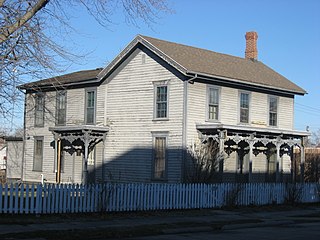
The Moore–Youse–Maxon House, also known as the Moore–Youse Home Museum, is a historic home located at Muncie, Delaware County, Indiana. It was built about 1860, and is a two-story, three-bay, vernacular Greek Revival style frame dwelling. It features a rebuilt front porch with sawnwork and brackets. It has a two-story rear addition. The house remained in the same family from 1864 to 1982. The building is operated by the Delaware County Historical Society as a historic house museum.
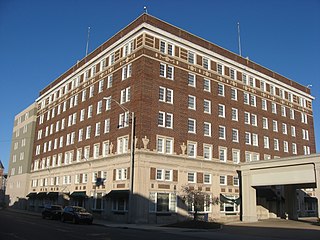
Roberts Hotel is a historic hotel located at Muncie, Delaware County, Indiana. It was built in 1921, and is a six-story, Colonial Revival style steel-frame building sheathed in red brick with limestone detailing. The basement, first, and mezzanine floors measure 120 feet by 125 feet, where the second through sixth floors above are L-shaped. It has a flat roof behind a parapet. The hotel closed in 1972, but reopened in 1976. The building has been renovated into loft apartments.

Boyce Block is a historic commercial building located at Muncie, Delaware County, Indiana. It was built in 1880, and is a two-story, brick building. The building features an elaborate parapet. Since 1904, the building has housed a theater.
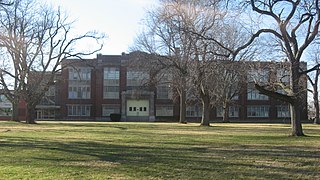
Wilson Junior High School is a historic junior high school located at Muncie, Delaware County, Indiana, United States. It was built in 1921, and is a three-story, U-shaped, Classical Revival style brick veneer building with a flat roof. Additions were made to the original building in 1927, 1954, and 1964. The building features ornamental brickwork.
